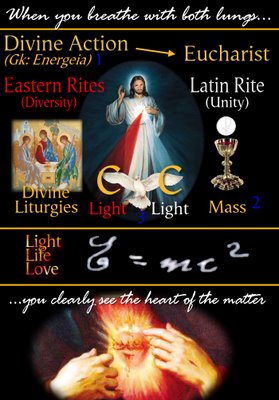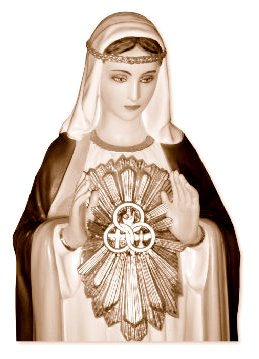
J.M.J. + O.B.T. + M.G.R.*
An excerpt from
The Art of Making Life Beautiful
presented by Catherine Michaud, CSJ
Theological Insights, October 11, 1996
Still we must ask what characterizes beauty? How do we determine what is truly beautiful? "Every work of art has form of one kind or another. Poetry makes use of metre, rhythm and rhyme; a novel has a beginning, a middle and an end and a host of subtle interconnections, parallels, echoes and contrasts in the text; and so on. Forms can and do change: as when Wilfred Owen made more use of half-rhymes, assonance and internal rhyming; as when Gerard Manley Hopkins developed his sprung rhythm [attempting to make the rhythm depict what he wrote about] . . . . But form there must be and without form there is no work of art." Yet forms vary enormously. The form is what distinguishes a painting from a splat of paint, music from cacophony, a novel or play from a rambling anecdote. In all of these the details relate to one another and to the whole in a way that achieves a satisfying unity—some kind of wholeness and harmony.
St. Thomas Aquinas believed beauty is a thing that possesses wholeness, harmony and radiance. He speaks of beauty as "a concordance and fittingness of a thing to itself and of all its individual parts to themselves and to each other and to the whole, and of that whole to all things." He believes a thing is beautiful if it has wholeness, harmony and radiance.
The Medieval Oxford scholar, Robert Grosseteste, describes beauty as a simple unity. He says, "Light is beautiful in itself, for its nature is simple and all things are like to it. Wherefore it is integrated in the highest degree and most harmoniously proportioned and equal to itself: for beauty is a harmony of proportions.” He considered the attributes of light to apply even more to God: “God is supremely simple, supremely harmonious, symmetrical, balanced and appropriate to the divine self.” The early Church theologians, St. Gregory of Nyssa, for example, held that God alone is beautiful, that God is the every essence and archetype of all beauty. God as the cause of all things is the source of all beauty.
The artist Botticelli demonstrates in his paintings the artist's absorption with harmony, radiance and the proportional principles of form and motion. In his painting, Primavera, he depicts the goddess Venus as the spirit of Love and springtime who, on the one hand, is assailed by the passionate and fertile Winds of Chloris and Zephyr, and on the other hand, is surrounded by four feminine, dancing figures: Flora who strews the pathways with flowers, and the three Graces who attend to love, Beauty, Pleasure and Restraint. In her garden "Venus is the mistress, and in her decorated and copious beauty, embellished by the splendor, grace, and blossoming youth of her dancing companions, she perfectly expresses and completely manifests that concinnitas. . ." that "cunning joining together of parts" as the "final expression of beauty in art." Concinnitas has its initial and special application in Ciceronian rhetoric, where it is used to mean both elegance and beauty of style, especially deriving from the skillful interconnection of words and clauses. The Primavera, based as it is on a story, demonstrates "the analogy between periodic sentence structure and pictorial composition." Concinnitas is a "quality that arises from the elegant arrangement and joining together of parts in a way that produces stylistic beauty" and reveals “a further quality in which beauty shines full face.” In other words, concinnitas is the law of nature in its absolute and fundamental sense openly manifested in art and adorned with every grace and splendor.
Does the fact that something possesses a wholeness, harmony and radiance make it beautiful? Perhaps it is merely pretty. "There is a world of difference between superficial prettifying and genuine beauty." What is it? What makes the difference? Is the beauty of a work of art diminished if it includes that which is disturbing and ugly, dark and disruptive? Can art express violence, evoke sorrow and depict the sordid and still be beautiful? I believe beauty must always be seen in integral relation to truth. Truth has to do with wholeness, harmony and radiance. Radiance needs to be interpreted broadly to include "illumination of all kinds: intellectual, moral and spiritual. Works of art not only satisfy the senses, they bring insight and challenge." This is to say that there are elements of beauty that can be recognized and discussed. The popular modern notion that 'beauty is in the eye of the beholder'; that beauty is a matter of personal taste; that there is nothing objective about beauty is, in my estimation, destructive; it eliminates shared criteria for judgment, it eliminates our common ground and therefore our basis for dialogue and growth. It is somehow thereby distanced from its relation to truth.
JESUS is beauty personified!
Mary is the person from whom
He received His beauty!
Sincerely yours in Jesus and Mary,
Mike Rizzio, SOLT
Imitate Mary
Become like Jesus
Live for the Triune God
Seek the Light of Our Lord Jesus Christ
See you on the High Ground!If you have a few minutes please go to the following sites
and see what I have been compelled to work on since 2004.
http://soltlaity.org/breadoflife.htm
http://soltlaity.org/slideshow.htm
I will attempt to answer any and all inquiries at jmjriz@aol.com.
+++
* - J.M.J. + O.B.T. + M.G.R. stands for: Jesus, Mary and Joseph;
O Beata Trinitas; St. Michael, St. Gabriel and St. Raphael






























No comments:
Post a Comment